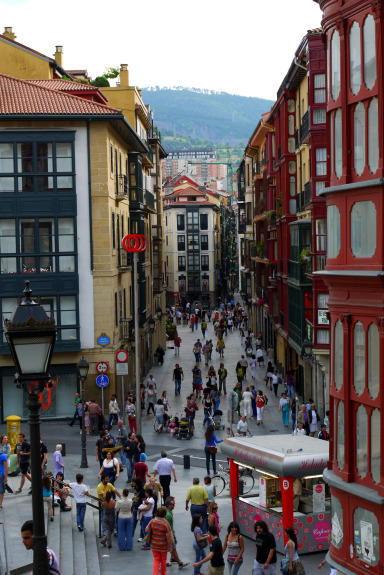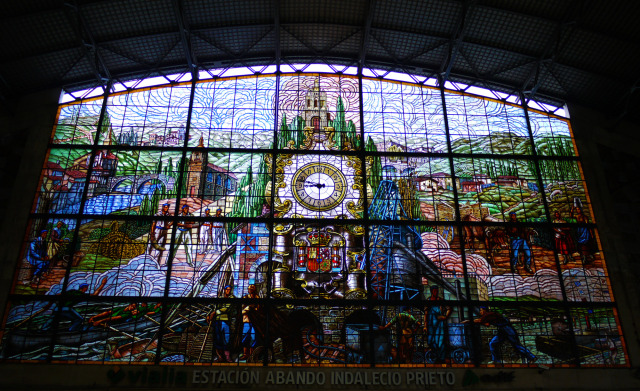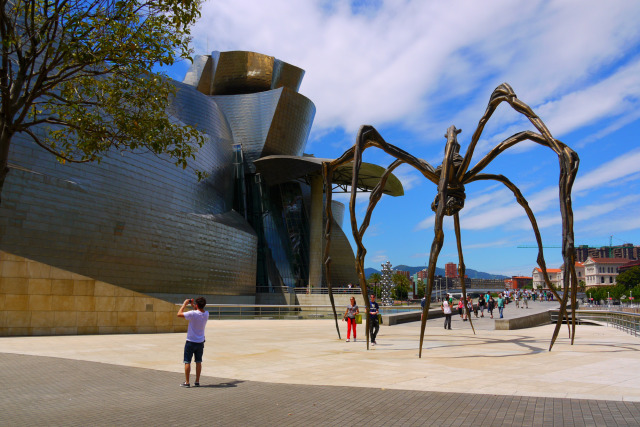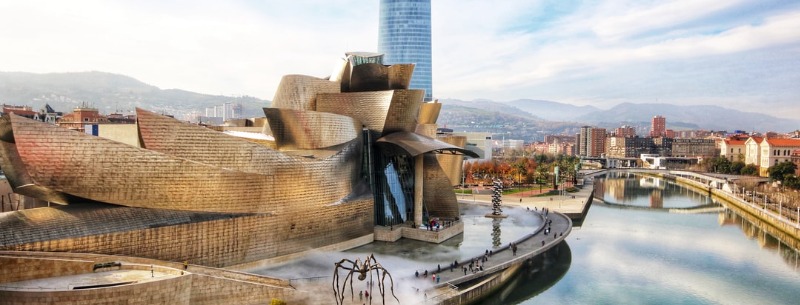Bilbao Attractions & Things to Do
Even though the Basque Country is slightly more expensive than the rest of Spain with a little bit of planning, you can leave Bilbao having seen lots of sights and still with some money in your pocket.
Bilbao, or the Botxo (Hole) as it has been affectionately nicknamed by its inhabitants, is a city being reborn. Gone are the symbols of its heavy industry past, to be replaced by one of Europe’s newest major art centers crowned by its shimmering silver fish, the Guggenheim.
The architecture of Bilbao is a variety of styles, and the new blends with the old, as each neighborhood proudly portrays its own character and history. The old town in particular, is a charming warren of bar-filled medieval streets. Furthermore, Bilbao is also the spiritual home of Basque culture with a wonderful array of monuments and sights. All in all, a pretty happening place.
1. Museum of Fine Art
Museo Plaza, 2, 48009 Bilbo, Bizkaia, Spain
8000 works on display for you to enjoy. Chillida, Soroya, Goya, El Greco, Van Dyck, Tapies, and Bacon are among the artists represented. Founded from a merger of two galleries in the early 20th century. The museum’s collection covers from the 12th century to the present day and contains an extraordinary variety of art works.
The Museo de Bellas Artes (Museum of Fine Art) contains over six thousand pieces including paintings, sculptures, drawings, engravings and objects from the decorative arts and is Free on Wednesdays for everybody; always for children younger than 12, the disabled and unemployed; also on Sundays between 2-8 p.m. for under 25′s.
2. Old Town
Casco Viejo (Old Town) is based around Seven streets, and many alleyways which form the medieval neighbourhood of Bilbao. Walking around it is a pleasure in itself.
Casco Viejo, or old town, sits on the east side of the city, to the east of the Ría de Bilbao (also known as the Río Nervión), which makes a sort of upturned “U” as it runs through the city. The Casco Viejo contains the Cathedral and siete calles (the original seven streets of Bilbao), and has the highest concentration of bars and accommodation options. Across the river from the Casco Viejo are the neighborhoods of Abando to the north (home of the majority of museums), Indautxu further south (where the night-life is after 2 a.m.), Basurtu to the southwest (location of the bus terminal), and Deusto west, across the river.

Probably the most colorful and definitely the most interesting part of the city. The old town contains several historical churches (San Antón, Santos Juanes, the Cathedral, San Nicolás), the Arriaga Theatre and many of the city’s bars and restaurants. The Zazpikaleak or Las Siete Calles (The Seven Streets) are: Somera, “upper”, Artekale “middle street”, Tendería “shopkeeper’s”, Belostikale, Carnicería Vieja “old butchery”, Barrenkale “lower street” and Barrenkale Barrena, “lower lower street”.
3. Azkuna Center
Azkuna Zentroa (Alhóndiga Bilbao) is a “Culture and Leisure Center” with wonderfully creative design including 43 pillars and a swimming pool with a glass floor. Walk through the foyer and enjoy.
One of Bilbao’s must-see attractions. It is both a cultural center and a work of art. It is an old wine warehouse that has been transformed into a hub of activity and life in the city. Its atrium contains 43 columns that represent various cultures, religions, wars, and architectural styles. Philippe Starck is the design’s emcee.
The building, originally a wine cellar, was renovated by French designer Philippe Starck in collaboration with Thibaut Mathieu in the modernist style. Today, the building is a “Culture and Leisure Centre” and consists of an auditorium, a cinema multiplex, a library, a fitness center, showrooms, shops, and a restaurant. What makes this building great is the creative design including 43 pillars and a swimming pool with a glass floor.
4. Church of St. Vicente Martir
Done Bikendi Plaza, 3, 48001 Bilbo, Bizkaia, Spain
Iglesia de San Vicente Martir (Church of St. Vicente Matir) constructed in the 16th & 17th centuries in the Gothic style; its features include a Renaissance façade with Triumphal Arch and a spectacular altarpiece, it is Free to visit.
The church was built in the Renaissance and Baroque styles. Juan de Arratia began construction on this church in 1549 and completed it in the mid-seventeenth century. The church has recently been restored. The church is divided into three naves, with the central nave being wider than the lateral naves. There are eight Doric columns with tall Tuscan capitals. Martin Ibaez de Zalbidea created the vault arches above the columns. Juan de la Pea constructed the main façade in 1556. There are three bells in the belfry. The lower section has a large pointed arch with a niche containing a statue of San Vicente.
5. Riverbank Market
Erribera Kalea, s/n, 48005 Bilbo, Bizkaia, Spain
Why not walk around the Mercado de la Ribera (Riverbank Market), the largest indoor market in Europe, and soak up the sights, sounds and smells of the Basque Country. Ten thousand square meters are divided into two floors. Apart from its impressive display windows, which are the originals that have been restored, this is a spectacular building with a central dome that you can’t miss. The heartbeat of the city’s commercial life serves as background noise.
Specializing in fish & seafood, the Riverbank Market was built in 1921 and is the largest indoor market in the world. The building itself is a columnless open space which has a unique, translucent material floor that enables natural light throughout the buildings. Outside, the Market is adorned with some interesting art-deco pieces including windows, lattice windows, floral decorations and other decorative elements.
6. Bilbao-Abando Train Station
48008 Bilbao, BI (Planta 0 y Planta 1, Spain
Take a trip to the Estación de Abando Indalecio Prieto (Bilbao-Abando Train Station) and marvel at the stained glass atrium depicting typical Basque jobs. OK, it is a train station but it does have one feature that is worth checking out. The impressive stained glass atrium is a real sight and depicts typical Basque jobs and workers in action.

7. La Ría Maritime Museum
Ramón de la Sota Kaia, 48013 Bilbo, Bizkaia, Spain
Museo Marítimo Ría de Bilbao (La Ría Maritime Museum) is housed in the former Euskalduna shipyard. The Maritime Museum’s structure alone is worth a visit, with the Carola crane resembling Bilbao’s Eiffel Tower. The museum is located near the Bilbao River, where the Euskalduna Shipyards once stood.
If you want to go inside to see the ships on display, you must pay an entrance fee. But it isn’t much, and it is worthwhile. All of the elements related to the ria of Bilbao, in the form of objects or models, can be found there.
They usually have temporary exhibits, like the “Titanic” one. It’s an odd museum worth visiting if you want to learn more about the sea.
From September to June, admission is free on Tuesdays.
8. Museum of Sacred Art
Encarnacion Plaza, 9B, 48006 Bilbo, Bizkaia, Spain
Museo Diocesano de Arte Sacro (Museum of Sacred Art) contains over 2000 pieces divided into three sections: escultura-pintura (sculpture & painting) orfebrería (jewellery) & ornamentos (ornaments) spanning from the 12th century to the modern age. It is Free on Thursday. Established in 1961, the museum is housed in Encarnación Church, an old Dominican convent, and contains over 2000 pieces with 500 on display at any one time. It is divided into three sections: escultura-pintura (sculpture & painting) orfebrería (jewellery) & ornamentos (ornaments) spanning from the 12th century to the modern age.
9. Guggenheim Museum Bilbao
Abandoibarra Etorb., 2, 48009 Bilbo, Bizkaia, Spain
Although it does cost to enter, simply walking around the Marvel at the Museo Guggenheim Bilbao (Guggenheim Museum Bilbao) is an unmissable treat. The museum has now become a symbol of the city, and while admission is required, the surrounding area has a lot to offer, and the pull effect caused by Gehry’s work will provide you with beautiful photographs of works of art and amazing architecture.

Designed by Canadian-American architect Frank Gehry, the Guggenheim Bilbao is a mass of twisted titanium and is one of the most celebrated buildings of the 20th century. It resembles a space age boat covered in glittering metal squares which evoke images of the scales of a fish whilst the huge skylights are made to look like fins. Whilst inside the collection is not the most impressive, there are regular temporary exhibitions frequently comprising some of the very best masterpieces from other Guggenheim branches.
If you spend more than an hour in this location, you will be pleasantly surprised by the “Escultura de Niebla” [The Mist Sculpture], a work by Japanese artist Fuyiko Nakaya. A white mist will engulf the museum and those who visit it. The “Fuente de Fuego” [The Fire Fountain] by Yves Klein can also be found here, but it only lights up at night from 7 to 8 in the winter and 9 to 10 in the summer.
10. Etxebarria Park
Etxebarria Parkea, 48005 Bilbo, Bizkaia, Spain
For an escape from the noise and for some wonderful views over the city head to Parque Etxebarria (Etxebarria Park). Etxebarria Park is a municipal park constructed on the site of a former steel foundry in the 1980s. Due to its position on the side of a hill the park has great views over the Abando and Casco Viejo districts. To reach the park from the Old Town, one can either climb the stairs on Plaza Unamuno or pay 0.40 € to use the Begoña lift (in the picture) from next to the entrance of Metro Casco Viejo.
11. Church of St. Antón
Erribera Kalea, 24, 48005 Bilbo, Bizkaia, Spain
Iglesia de San Antón (Church of St. Antón) was built on the foundations of the city’s original Alcázar (Fortress) in the Gothic style. The Belfry, built in the Baroque dieciochesco style, is one of the best examples of its kind in the whole Basque Country and is Free to visit.
Originally built on the foundations of the city’s original Alcázar (Fortress) in the Gothic style, the Church of San Antón has three chapels: Chapel of Provost, Chapel of Piety and the Chapel of San Roque. A notable feature of the church is the Renaissance façade testament to the amount of work that has been done on the church over the passage of time. The Belfry, built in the Baroque Dieciochesco style one of the best examples of its kind in the whole Basque Country.
12. New Square
Sit and have a sandwich on the Neo-classical public square of Plaza Nueva (New Square), lean against an arch or take a coffee and wath the world go by. Home of the Euskaltzaindia, the Basque Language Royal Academy. This wonderful square was built in 1821 as the main site of the Biscay Government. The square itself is accessed under arches known as cuevas (caves). Every Sunday there is a flea market to be enjoyed on the square.

13. Basque Museum
Unamuno Miguel Plaza, 4, 48006 Bilbo, Bizkaia, Spain
Euskal Museoa (Basque Museum) is the first stop for those wanting to learn about all things Euskala. Established in 1921 with a brief to focus upon the roots, archaeology, ethnography and history of Euskadi, the Basque homeland. The museum is not the best organised but might have interest for those wishing to learn more about Basque culture.
It is Free for Senior citizens & Children and Free on Thursday.
14. Bilbao Town Hall
Ernesto Erkoreka Plaza, 12, 48007 Bilbo, Bizkaia, Spain
Ayuntamiento de Bilbao (Bilbao Town Hall) is Free to visit but make sure to come on Monday – Friday: 9 a.m., 9.30 a.m. or 10 a.m for a guided tour. Built in 1892 on the site of the former Convent of St. Agustín by the architect Joaquín Rucoba, the Town Hall contains an elegant spire and façade punctured by balconies and colonnades. Inside the impressive Salón Árabe (Arabic Hall) designed by Jose del Solar is perhaps the highlight.
15. Rio Nervion
Take a stroll along the Rio Nervion and admire the quirky architecture of Bilbao, it is at times both weird and wonderful.
16. Biscay Foral Delegation Palace
Calle, Gran Vía de Don Diego López de Haro, 25, 48009 Bilbao, Spain
Palacio de la Diputación Foral de Vizcaya (Biscay Foral Delegation Palace) is probably the best example of eclecticism in the whole of the Basque Country. Today the seat of the executive branch of the Government of Biscay, the palace was built between 1890 and 1900 by architect Luis Aladren. It is probably the best example of eclecticism in the whole of the Basque Country. The interior of the palace is noted for its grand staircase and decoration, with lavish use of marble, wood, stucco, mirrors, plaster, vases, ceramics, stained glass and paintings by important artists of the late nineteenth century.
It is Free but make sure to come on Monday – Friday: 10:30 a.m., 11:30 a.m., 12:30 p.m., 5 p.m. or 6 p.m. for a guided tour.
17. St. Antón Bridge
Walk across the Puente de San Antón (St. Antón Bridge) an arched bridge that it one of the emblems of the city. Constructed originally in 1381 it is the oldest bridge in the city and appears on the city’s crest of arms. It has been reconstructed many times with the most recent destruction befalling it during the Spanish Civil War.
Where is it? Spans the Estuary of Bilbao and links the neighborhoods of Bilbao La Vieja and Casco Viejo, next to the Church of San Antón.
Nightlife in Bilboa
The nightlife in Bilbao is lively and fun and the Basques certainly know how to party until the small hours. Bar crawling is a national pastime here with young people moving quickly between the pubs raking up the alcohol points as they go. So, whether it is enjoying some of the world’s finest cuisine, drinking beer on the street or dancing the night away, there is something for all tastes.
During the weekends Casco Viejo (Old Town) young people fill the bars around Barrenkale and Barrenkale Barrena streets. On close-by c/Perro, a mixed crowd practise one of the most popular customs in the city: “poteo” or “txikiteo” (bar hopping). There are also numerous bars offering live music with everything from rock to Spanish-style cheese.
On c/ Mazarredo (near the Guggenheim) can be found late-night Bilbao with numerous clubs and disco’s playing a range of electronic and other genres of music.
c/ Licenciado Poza, more simply known as “Pozas”, is located in Indautxu and is swamped with revellers nearly every day. On the whole, Indautxu is a little bit more upmarket than the old town, and the drinks are also a little more expensive.
c/ Ledesma contains many cafés and bars, and is popular with the 30 something crowd.
Across the San Antón bridge, on the south bank to the old town lies Bilbao la Vieja home to the gay scene in Bilbao. It attracts a good mix of people and is famed for its gay bars and clubs.
Bilbao History
Founded by the then lord of Biscay, Diego López V of Haro in the 14th century, the city eventually rose to become the capital of Biscay in 1602, an event that was followed by centuries of economic growth, fueled by trade in Iron Ore with England and the Netherlands.
During the Carlist War it became one of the prominent battlegrounds as Carlist besiegers where thrice thrown back from the walls of the city. It was during this period that Bilbao underwent a dramatic period of industrialization, making it one of the eminent economic powerhouses of Spain.

At the outbreak of the Spanish Civil War, the Nationalist uprising was initially resisted, but an intense bombing campaign, augmented by German and Italian aircraft eventually broke its resistance and it fell to Nationalist forces in May 1937. What followed was a period of brutal repression against those that had taken up arms against the coup.
The Francoist period witnessed the birth in the city of the now infamous Basque separatist group ETA in response to the stifled calls for self-rule and Basque independence.
Since the transition to democracy, Bilbao has undertaken a project of de-industrialization and the transition to a service economy as evidenced by investment in infrastructure and urban renewal. This is most notably seen in the construction of the Guggenheim Museum and the so-called ‘Bilbao Effect’.
Due to its proximity to the Bay of Biscay, Bilbao endures and Oceanic climate with rain falling throughout the year. Summers and winters are both mild with average maximum temperatures in the summer of 12°C – 26°C and in the winter 4°C – 14°C.
